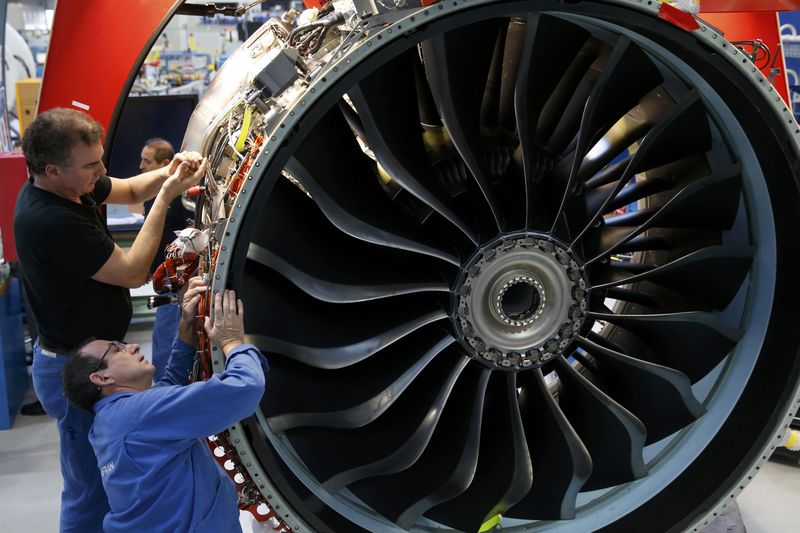By Cyril Altmeyer and Tim Hepher
VILLAROCHE, France (Reuters) - Airplane orders may be slowing this year, but jet engine makers are ramping up production with a large chunk of the industry’s profits riding on the flawless operation of a high-tech factory in the French countryside.
As revamped medium-haul models emerge from Airbus and Boeing (N:BA), French engine maker Safran (PA:SAF) and its U.S. partner General Electric (N:GE) are running ahead to reach a newly expanded goal of producing 2,000 new-generation LEAP engines a year by 2020.
Their CFM International joint-venture controls three quarters of a market valued at $600 billion over 20 years for engines for narrowbody jets, and any delays could rattle both plane giants and their global suppliers.
With eight years' of orders in the bag, CFM is beginning a record-quick climb in output to deliver the successor to the industry's most-sold engine, the CFM56.
"We have sold 10,000 LEAP engines before we even delivered one. It took us 17 or 18 years to get to the same point with the CFM56," LEAP director Sebastien Imbourg told Reuters.
Some analysts worry a recent boom in orders is overheating, with U.S. aerospace stocks underperforming by 12 percent this year.
But at a 212-acre factory complex outside Paris, and similar plants in the United States, the talk is only about how to raise output and monitor time and quality, both of which translate into cost.
“We are preparing as never before in our history,” said Cedric Goubet, Safran's civil engines director.
The Villaroche site employs 4,500 workers and assembles one in five CFM engines for Boeing and all the CFM engines sent to Airbus, whose A320 can also be sold with Pratt & Whitney motors.
The first revamped Boeing 737 MAX made its maiden flight with LEAP-1B engines last week. The Airbus A320neo entered service with Pratt & Whitney (N:UTX) engines last month.
Tucked inside giant cradles capable of flipping engines like pancakes to help workers inspect them, the first CFM engines for Airbus, known as LEAP-1A, are due to delivered to the planemaker in April and should enter service in July.
Safran says the supply chain is humming essentially as it should, but not without tensions.
"We had some areas at red and now at amber," Imbourg said, referring to troubleshooting codes.
"There are areas where we need to work ... but red spots which risk the entry to service of the (LEAP) 1A? No."
STRESS TESTS
Airbus missed a goal of delivering the first A320neo in 2015 because of glitches surrounding Pratt & Whitney's engine, which has also had teething problems over the engine start-up process.
Safran insists LEAP's performance will be on par as soon as it enters service. Since both types are designed for aircraft that fly half a dozen trips per day, slip-ups can be costly.
"What airline customers want is that we stick to promises. Many people talk about the future but miss the present,” Imbourg said.
With Airbus and Boeing both recently announcing increases in production, CFM has set a new target of 2,000 engines a year in 2020, up from 1,800.
At record aerospace volumes, any bottlenecks can quickly undermine the programme and ripple throughout the sector.
To prevent this, CFM runs regular "stress tests," where suppliers have to operate for 1-2 weeks at speeds that won't be seen in reality for 18 months. One of the most critical stepping stones will be between 2018 and 2019.
This year CFM will build 100 LEAP-1A for Airbus, 50 LEAP-1B for Boeing and 3-4 test engines for China's new C919 jetliner.
That will rise to 300 engines in 2017.
Safran and GE are also doubling up on their own suppliers to reduce the risks of a single point of failure and aim for the first time to spread 'dual sourcing' throughout the LEAP engine.
That means a "very strong reduction in risk," Imbourg said.
Existing CFM56 suppliers were vetted before being allowed on the successor programme. Some did not make the cut, Imbourg said, declining to give names.
Some 50 new factories have been built at suppliers to support the LEAP programme, including 20 in France where some industry leaders have expressed concerns about the ability of small suppliers to invest in new capacity.
CFM has not been without its own test flight problems, with a delay of 1-2 weeks last summer due to a faulty part. Last year it denied reports it was missing performance goals.
"In a few months we will see who has really kept their promises ... and how our customers react," Imbourg said.

"I sleep well today," he added. "I don't say I sleep a lot, but I sleep well."